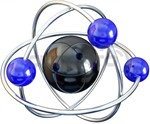Solution of the variant 17 KR №1 - chemisty Shimanovich
Content: Вариант 17.RAR (125.52 KB)
Uploaded: 01.06.2016
Positive responses: 0
Negative responses: 0
Sold: 0
Refunds: 0
Seller: Михаил_Перович
information about the seller and its items
Loyalty discount! If the total amount of your purchases from the seller more than:
| $1 | the discount is | 1% |
| $5 | the discount is | 2% |
| $10 | the discount is | 3% |
| $20 | the discount is | 5% |
| $50 | the discount is | 7% |
| $100 | the discount is | 10% |
| $200 | the discount is | 15% |
$2.53
The decision of the test No. 1 of option 17 of the collection of chemistry Shimanovich I.E.
(designed in Microsoft Word)
Tasks:
17. Upon interaction of 3.24 g of a trivalent metal with an acid, 4.03 liters of hydrogen (NU) are released. Calculate the equivalent, molar and atomic mass of the metal.
37. Write down the electronic formulas of atoms of elements with serial numbers 24 and 33, taking into account that the first has a "dip" of one 4s-electron to the 3d-sublevel. What is the maximum spin of d-electrons for atoms of the first and p-electrons for atoms of the second elements?
57. The atomic masses of elements in the periodic table are continuously increasing, while the properties of simple bodies change periodically. How can this be explained? Give a motivated answer.
77. What electrons of the boron atom are involved in the formation of covalent bonds? How does the valence bond method (VS) explain the symmetric triangular shape of the BF3 molecule?
97. The reaction of ammonia combustion is expressed by the thermochemical equation:
4NH3 (g) + 3O2 (g) = 2N2 (g) + 6H20 (g); H = -1530.28 kJ.
Calculate the heat of formation of NH3 (g). Answer: -46.19 kJ / mol.
117. Based on the standard heats of formation and the absolute standard entropies of the corresponding "substances, calculate the Gо298 of the reaction proceeding according to the equation:
C2H4 (g) + 3O2 (g) = 2CO2 (g) + 2H2O (g)
Is this reaction possible under standard conditions? Answer: -1331.21 kJ
137. The equilibrium constant of the homogeneous system N2 + 3H2 2NH3 at a certain temperature is equal to 0.1. The equilibrium concentrations of hydrogen and ammonia are 0.2 and 0.08 mol / l, respectively. Calculate the equilibrium and initial nitrogen concentration. Answer: [N2] p = 8 mol / l; [N2] ref = 8.04 mol / l.
157. Mixed 300 g of a 20% solution and 500 g of a 40% NaCl solution. What is the percentage of the resulting solution? Answer: 32.5%.
177. How many grams of urea (NH2) 2CO should be dissolved in 250 g of water to raise the boiling point by 0.26 °? Ebullioscopic water constant 0.52 °. Answer: 7.5 g
197. Make molecular and ion-molecular equations of interaction reactions in solutions between:
a) H2SO4 and Ba (OH) 2;
b) FeCl3 and NH4OH;
c) CH3COONa and HCl.
217. Make up the ionic-molecular and molecular equations for the hydrolysis of a salt, the solution of which has:
a) alkaline reaction;
b) acid reaction
(designed in Microsoft Word)
Tasks:
17. Upon interaction of 3.24 g of a trivalent metal with an acid, 4.03 liters of hydrogen (NU) are released. Calculate the equivalent, molar and atomic mass of the metal.
37. Write down the electronic formulas of atoms of elements with serial numbers 24 and 33, taking into account that the first has a "dip" of one 4s-electron to the 3d-sublevel. What is the maximum spin of d-electrons for atoms of the first and p-electrons for atoms of the second elements?
57. The atomic masses of elements in the periodic table are continuously increasing, while the properties of simple bodies change periodically. How can this be explained? Give a motivated answer.
77. What electrons of the boron atom are involved in the formation of covalent bonds? How does the valence bond method (VS) explain the symmetric triangular shape of the BF3 molecule?
97. The reaction of ammonia combustion is expressed by the thermochemical equation:
4NH3 (g) + 3O2 (g) = 2N2 (g) + 6H20 (g); H = -1530.28 kJ.
Calculate the heat of formation of NH3 (g). Answer: -46.19 kJ / mol.
117. Based on the standard heats of formation and the absolute standard entropies of the corresponding "substances, calculate the Gо298 of the reaction proceeding according to the equation:
C2H4 (g) + 3O2 (g) = 2CO2 (g) + 2H2O (g)
Is this reaction possible under standard conditions? Answer: -1331.21 kJ
137. The equilibrium constant of the homogeneous system N2 + 3H2 2NH3 at a certain temperature is equal to 0.1. The equilibrium concentrations of hydrogen and ammonia are 0.2 and 0.08 mol / l, respectively. Calculate the equilibrium and initial nitrogen concentration. Answer: [N2] p = 8 mol / l; [N2] ref = 8.04 mol / l.
157. Mixed 300 g of a 20% solution and 500 g of a 40% NaCl solution. What is the percentage of the resulting solution? Answer: 32.5%.
177. How many grams of urea (NH2) 2CO should be dissolved in 250 g of water to raise the boiling point by 0.26 °? Ebullioscopic water constant 0.52 °. Answer: 7.5 g
197. Make molecular and ion-molecular equations of interaction reactions in solutions between:
a) H2SO4 and Ba (OH) 2;
b) FeCl3 and NH4OH;
c) CH3COONa and HCl.
217. Make up the ionic-molecular and molecular equations for the hydrolysis of a salt, the solution of which has:
a) alkaline reaction;
b) acid reaction
No feedback yet
